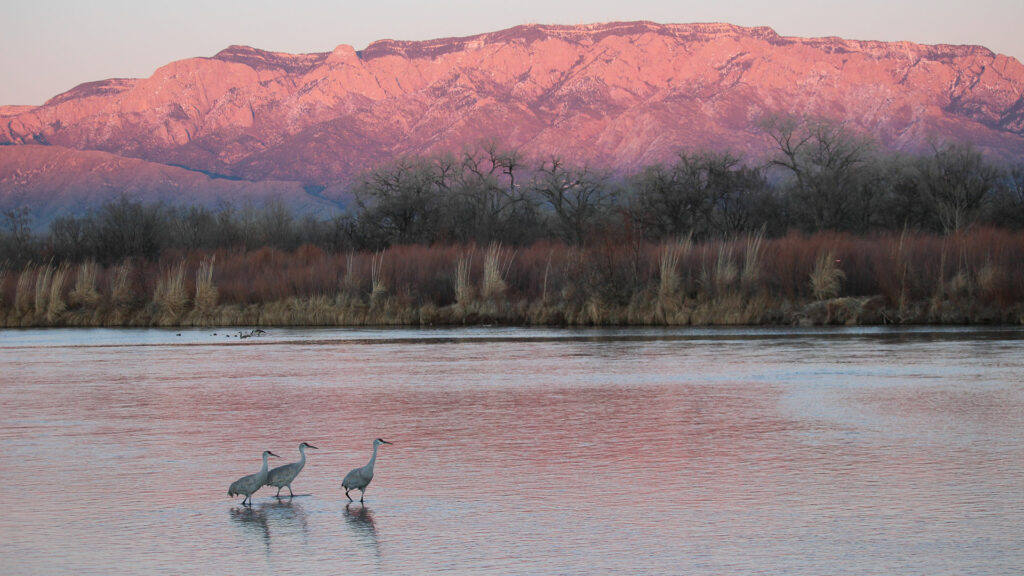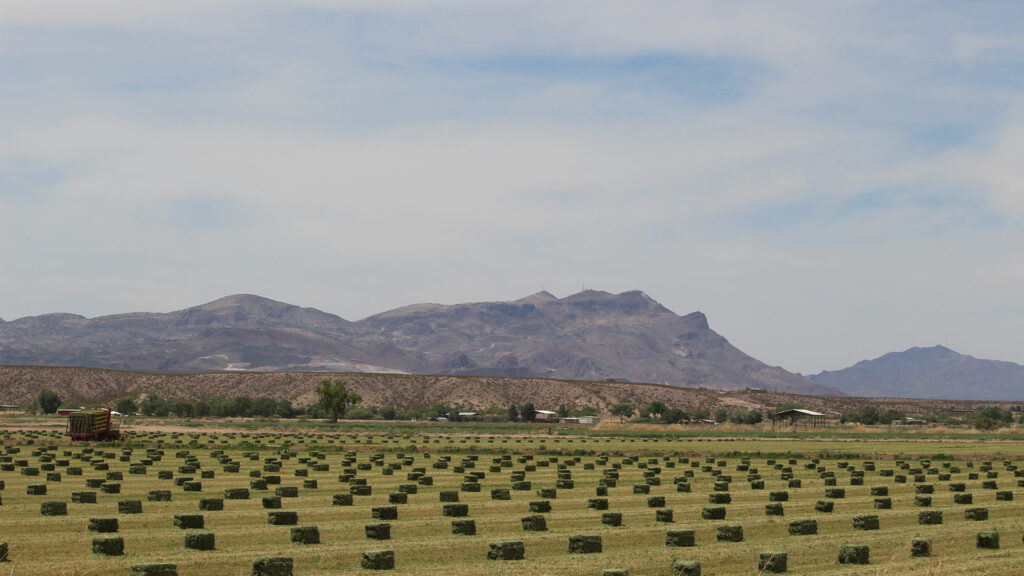Already ‘baked in,’ NM’s water challenges loom large on the political landscape
Laura Paskus

New Mexico officials know that continued warming is drying out the state’s rivers, farmlands, forests, and reservoirs. And while there are plans to address some of those challenges, state water experts say they lack resources to implement changes.
This summer, more than 30 miles of the Middle Rio Grande dried. Farmers in that region, as well as further south, in the Elephant Butte Irrigation District, received lower-than-normal water allocations. For the second year running, the Albuquerque Bernalillo Water Utility had to rely exclusively on groundwater pumping during the summer and fall. Statewide, streams, rivers, and reservoirs are low. And the forecast for this winter is another warm one, and another dry one.
The impacts of climate change are “baked in” with the amount of greenhouse gases already present in the atmosphere, said Norman Gaume, former New Mexico Interstate Stream Commision director in an interview early last week.
“New Mexico is going to be much drier and much warmer and is going to have much less water,” he said. “Put that decline in our water on top of the fact that we’re already using more water than is sustainable in most areas of the state.”
Addressing these problems boils down to “facing our problems,” Gaume said. But both the “public demand” and the “political appetite” for serious changes in water management have yet to occur, he said.
Water policy and funding doesn’t appear high on the New Mexico State Legislature’s agenda, Gaume said. And while Gov. Michelle Lujan Grisham published an “excellent water policy platform” during her election campaign in 2018, he said water hasn’t been a priority during her administration.
“The best thing that could happen to us would be if she would turn her attention to that and actually see it implemented,” Gaume said. “It may not do everything we need to do, but it would be a wonderful start.”
And clearly, New Mexico’s top water officials are feeling the crunch of inaction and inattention.
Water boss: ‘We’ve taken the agency as far as we can’
Last Wednesday, three of New Mexico’s top water officials announced their resignations to fellow staff.
John D’Antonio, New Mexico’s State Engineer, had submitted his resignation to Gov. Michelle Lujan Grisham on October 31, saying he would stay in the job until the end of the year. As State Engineer, D’Antonio also serves as secretary of the Interstate Stream Commission, Rio Grande Compact Commissioner, Costilla Creek Compact Commissioner, the governor’s representative on the Colorado River, Upper Colorado River Compact Commissioner, and chairman of the Water Trust Board.
In a list of discussion points, D’Antonio noted that “we’ve taken the agency as far as we can, given the current agency staffing level and funding resources.”
Other issues he cited in his resignation memo include:
- For nearly 3 years we’ve been asking for additional staff and funding to protect the state’s water resources. We have been directed to submit a flat budget for FY 23 despite strong financial revenue projections.
- Glaring non-response from the legislature on funding the 50-Yr Water Plan for the last 3 years with expectations that it be completed regardless of funding limitations.
- 67 fewer Full Time Equivalent (FTEs) than our agency had during the Richardson administration.
- Unfunded mandates on recent legislation such as the Cannabis Regulation Act further strains our limited staff.
- Inability to retain highly experienced professional staff due to non-competitive pay structure.
D’Antonio’s resignation came along with that of Interstate Stream Commission General Counsel Arianne Singer and Office of the State Engineer General Counsel Greg Ridgley.
The news reverberated throughout the New Mexico water community last week. Speaking on background, one high-level water attorney in the state said he was “terrified” about what it means for New Mexico’s water future.
Known for an even disposition and the ability to get along with various agencies, commissions, and states, D’Antonio returned to state government in 2019, at the request of Lujan Grisham.
He’d previously served as State Engineer from 2003 to 2011, appointed by Gov. Bill Richardson and remaining for almost a year under Gov. Susana Martinez. When Lujan Grisham’s transition team approached him in 2018, he was working for the U.S. Army Corps of Engineers.
Asked at that time, why he would want to head the state agency again, especially given New Mexico’s water challenges, D’Antonio said he didn’t initially apply for the position. “But as I spoke to the transition team…and noting how much of a challenge we have as a state, I thought it was important to have someone coming back in that could pull a lot of things together,” he said.
Even at the time of that interview, early in 2019, D’Antonio was worried about the agency’s budget. Then, roughly one-quarter of the staff positions were empty.
New leadership, new opportunities
“I will miss many of the folks who chose to leave,” said Rep. Nathan Small, D-Doña Ana. But he thinks there is now an opportunity to “move forward aggressively” on the state’s water challenges.
He acknowledged the legislature’s need to fund the water agency’s budget at a level commensurate with the challenges. But, he said, since 2019 the legislature has increased the Office of the State Engineer’s budget by about 11 percent. And on average, he said, about ten percent of the agency’s total budget, about $3.8 million, remained unused.
Agencies can request that unused money — budgeted toward staffing positions that aren’t filled — be redirected toward other projects. When that request isn’t made, Small said, the money is returned to the state’s general fund.
Small also noted the need for “new ideas for more comprehensive and innovative water management issues, [and] I rarely saw those originate within the Office of the State Engineer.”
“As we look forward with strong budgetary capacity, with a clear and keen understanding of the stresses that the climate crisis places upon New Mexico’s core water infrastructure and the ways that our systems of water use have been set up, I am very hopeful for a strong, active, and innovative partner,” Small said of the agency’s leadership: “One that is committed to using all of the funding capacity that the legislature appropriates—which has not been the case for the last few years—and is a part of bringing forward new tools and stronger collaboration with regional stakeholders, be those acequias, irrigation districts, or the myriad other stakeholders.”
Rep. Andrea Romero, D-Santa Fe, “absolutely agrees” that the state’s water agencies are underfunded—and said a subcommittee of the Water and Natural Resources Committee is looking into the agency’s budget and performance. Through those efforts and proposed legislation, as well as improving transparency and data, she’s optimistic.
“I’m hopeful about continuing to modernize the system of water governance in the state, and what we can do to improve the process,” she said. “And, with new leadership, comes new opportunities.”
In an email, the governor’s press secretary, Nora Meyers Sackett, wrote of gratitude for D’Antonio’s “critical work to protect New Mexico’s water resources” and said the office will continue that work and fill the State Engineer job as quickly as possible.
“We are working expeditiously to address the state’s most pressing water challenges, including unprecedented drought, low reservoir levels and inequities around access to water in some New Mexico communities,” Meyers Sackett wrote. “A priority of this administration remains the completion and implementation the state’s 50-year water plan and an active, cross-agency planning process is underway. With the effects of climate change mounting, we must ensure we are prepared for and resilient to its effects, and water is of the utmost importance, especially in the American Southwest.”
She added that New Mexico’s spending efforts will be augmented by hundreds of millions of federal dollars via the Biden administration’s Infrastructure Bill, which will “enable once-in-a-lifetime investments in our water planning and infrastructure.”

Gaume: NM on the ‘verge’ of another compact violation
In D’Antonio’s resignation memo, he noted his own optimism on the state’s position in the U.S. Supreme Court lawsuit playing out on the Lower Rio Grande, where New Mexico is embroiled in a disagreement with Texas, and now, the federal government. The downstream state alleges that New Mexico is violating the Rio Grande Compact by allowing farmers to pump groundwater, and thereby draw water from the system that should be flowing downstream in the river.
The state of Texas sued Colorado and New Mexico, filing No. 141, Original: Texas v. New Mexico and Colorado, in 2013. The following year, the United States joined forces against New Mexico, saying the state’s actions have harmed its ability to deliver water under the Rio Grande Compact and the international treaty with Mexico.
D’Antonio wrote that the first phase of the trial is complete, and “we are very optimistic that NM has greatly mitigated its liability exposure.” He added the state is moving into a “possible mediated settlement phase.”
But Gaume said the Lower Rio Grande isn’t the only place New Mexico has to worry about lawsuits.
“In the Middle Rio Grande, we’re on the verge of another Rio Grande Compact violation,” he said.
Under the Rio Grande Compact of 1938, Colorado, New Mexico, and Texas share water based on how much is physically present in the river each year. Colorado’s water deliveries to New Mexico, for example, are based on flows past the Lobatos stream gage. And New Mexico’s deliveries to Texas are calculated by the sum of the measured flow below Elephant Butte Dam for the year and the change in storage within the reservoir. When states deliver additional water downstream, they accrue credits. When they don’t move the required water, debits.
And right now, New Mexico owes Texas more water.
“We’re behind, seriously behind, and our debit is going to get worse this year,” said Gaume, warning that Texas could sue New Mexico again, putting the issue behind closed-door litigation. “We must pay attention to that and not let control slip out of our hands because we have violated the limit of our debit.”
According to the U.S. Bureau of Reclamation, New Mexico’s debit was about 91,000 acre-feet in 2020. That includes 38,000 acre-feet of water the state of New Mexico essentially borrowed from Texas that summer as part of an emergency release of water for farmers in the Middle Rio Grande Conservancy District.
By the end of October 2021, New Mexico had accrued an additional 46,000 acre-feet of debit – although the Bureau of Reclamation anticipates the final debit for 2020 and 2021 will be closer to 100,000 acre-feet.
That’s due to estimated daily river flows, as well as “prior and paramount” water that the six Middle Grande Pueblos did not use this year, water that Reclamation plans to move into Elephant Butte Reservoir by the end of December.
With reservoirs already tapped out – and La Niña conditions forecast for the winter – it’s unclear, however, when or how New Mexico might catch up on deliveries to Texas.
“We have to use less water in the Middle Rio Grande or deliver it downstream more effectively and efficiently with fewer losses. Those are the only two answers and we haven’t decided how to do that,” Gaume said.
Whether it’s problems on the Rio Grande, or elsewhere across New Mexico, “We know what’s coming, we need to plan for what’s coming,” said Gaume. “We need to figure out what the best solutions are and then we need to implement those solutions, instead of putting them on the shelf and letting them go unattended. That’s where New Mexico has been on water issues for a long, long time.”
He added, “We the people of New Mexico need to demand that our leaders face up to our water problems and help us deal with our future.”

